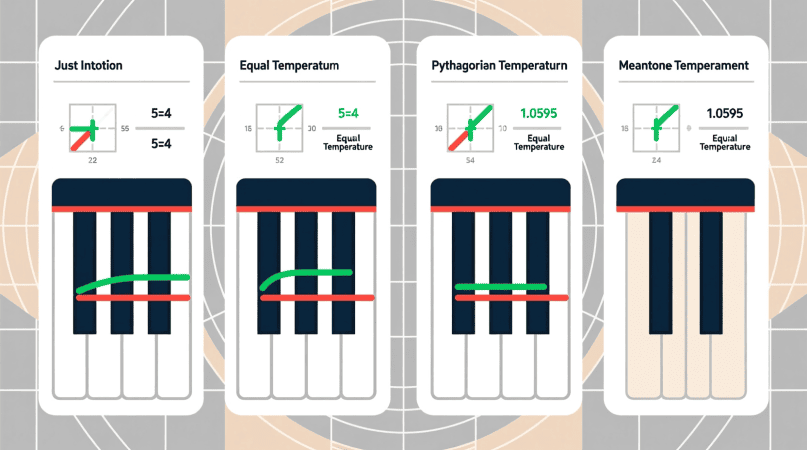
When you sing or tune an instrument, you’re not just matching pitch — you’re aligning with a tuning system.
Two concepts define how we perceive and measure tuning:
- Intonation — how accurately you produce pitch.
- Temperament — how the instrument itself divides and adjusts pitch.
Together, they determine whether something “sounds in tune” — both to the ear and to your Pitch Detector.
What Is Intonation?
Intonation refers to how closely a note matches its intended frequency.
It’s the performer’s precision — how “true” the sound is to the target pitch.
For singers and instrumentalists:
- Good intonation = consistent, centered pitch
- Poor intonation = drifting sharp or flat
Vocal Intonation Example
When using the Voice Pitch Analyzer, if you see:
- A stable line near the target note = good intonation
- A wavy or fluctuating line = inconsistent pitch control
Practice Tip:
Try our Vocal Warm-Up Exercises to stabilize your pitch production and muscle memory.
What Is Temperament?
Temperament defines how musical intervals are spaced across an instrument or scale.
Before modern tuning, instruments were tuned by “pure” mathematical ratios — but these pure intervals didn’t fit evenly into an octave.
Temperament is the system that adjusts those intervals to make all keys usable.
Equal Temperament — The Modern Standard
Equal Temperament divides the octave into 12 equal semitones, each a frequency ratio of:
2^(1/12) ≈ 1.059463
That’s the system your Pitch Detector and all modern instruments use.
Benefits
- You can play in any key — all sound equally “in tune.”
- Transposing is easy (keyboards, guitars, digital instruments).
- The A440 reference (see A440 Explained) integrates perfectly.
Tradeoff
- Intervals are slightly imperfect compared to pure ratios.
- But the difference is so small that the human ear adjusts automatically.
Example:
A “pure” perfect fifth has a ratio of 3:2 = 1.5
Equal temperament fifth = 1.4983 — slightly compressed but balanced across all keys.
Just Intonation — The Pure System
Just Intonation uses exact harmonic ratios from the natural overtone series.
It sounds incredibly smooth — but only in certain keys.
Ratios in Just Intonation
| Interval | Ratio | Frequency (if A = 440 Hz) |
|---|---|---|
| Unison | 1:1 | 440 Hz |
| Major Third | 5:4 | 550 Hz |
| Perfect Fifth | 3:2 | 660 Hz |
| Major Sixth | 5:3 | 733 Hz |
When you change keys, these ratios don’t align perfectly — which is why pianos, guitars, and digital tuners use equal temperament instead.
Other Temperament Systems (Historical Overview)
| Temperament | Era | Description | Character |
|---|---|---|---|
| Pythagorean | Ancient Greece | Based on perfect fifths (3:2) | Bright but dissonant thirds |
| Meantone | Renaissance | Narrowed fifths for better thirds | Warm and resonant |
| Well Temperament | Baroque | Uneven key spacing (used by Bach) | Expressive key colors |
| Equal Temperament | Modern | 12 equal semitones | Balanced and universal |
Learn how these evolved in Historical Pitch Standards.
Intonation vs Temperament — Key Differences
| Aspect | Intonation | Temperament |
|---|---|---|
| Who Controls It | Performer (voice or instrument) | Instrument builder or tuning system |
| Focus | Accuracy of single pitch | Relationship between pitches |
| Measurement Tool | Pitch Detector, Voice Analyzer | Frequency-to-note mapping |
| Errors | Sharp/Flat singing, drift | Key-dependent tuning differences |
| Can Be Fixed By | Practice, feedback, ear training | Retuning or digital correction |
Both matter:
- Good intonation keeps your pitch centered.
- Consistent temperament keeps harmony sounding balanced.
Why Pitch Detectors Use Equal Temperament
Pitch detectors like ours assume A4 = 440 Hz and equal temperament because:
- It’s the most widely accepted global system.
- It ensures every note can be compared objectively.
- It works with all modern instruments and digital audio.
Your reading (e.g., C♯4 = 277.18 Hz) is calculated using that standard — see the Frequency-to-Note Converter for details.
How Temperament Affects Perceived Intonation
Even if your pitch is mathematically correct, your ear might perceive slight variations depending on temperament:
- Equal temperament: slightly compressed intervals, but consistent across keys.
- Just intonation: smoother within a single key, harsher when transposed.
That’s why singers often “tune by ear” — slightly adjusting intonation to blend harmonically in the moment.
This phenomenon is known as adaptive intonation, and it’s one reason why the Voice Pitch Analyzer helps visualize pitch accuracy in context, not just numbers.
How to Practice Intonation With a Pitch Detector
- Sing long, sustained notes (5–10 seconds).
- Watch for drift — aim for a stable line in the Voice Pitch Analyzer.
- Try intervals (3rds, 5ths, octaves) — listen for “beats” (wobbling sound) when you’re off.
- Use drones tuned to A440 for reference.
- Experiment: Try singing the same interval using A432 and A440 — feel the difference in warmth and tension.
Pitch Detector is a project by Ornella, blending audio engineering and web technology to deliver precise, real-time pitch detection through your browser. Designed for musicians, producers, and learners who want fast, accurate tuning without installing any software.
